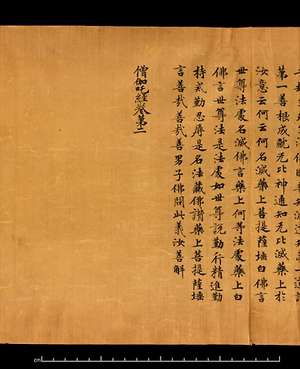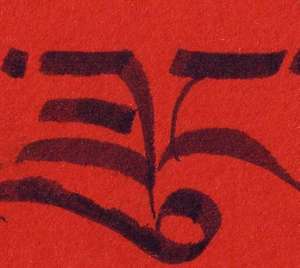Translation history: The Sanghāta in its many forms
Table of Contents
Re-discovery of the Sanskrit
The Sanghāta was first written down in Sanskrit, and as with all other Buddhist sutras, is assumed to have circulated orally for quite a long time before it was committed to paper—or, in the case of the Sanghāta, to palm leaves and birch bark, the medium most manuscripts were written on in India and northwest India. Historical research indicates that the Sanghāta was a major text for Buddhist communities in the northwest of India and central Asia, until at least the 8th century.
However, until the 1930s, records of the Sanskrit Sanghāta were completely lost. Then, in 1931 and 1938, at least seven Sanskrit manuscripts were recovered from Gilgit in northern Pakistan. It was only after these Sanskrit manuscripts emerged and began to be studied by scholars that the Sanghāta began to attract more attention, quickly coming to the revered position it holds today for many Buddhists.
Manuscripts of the Sanghāta have been recovered not only in Gilgit, but also in northern Pakistan; in the silk road oases of Khotan and Dunhuang; and other sites in Chinese Turkestan. The lack of substantial caches of Sanghāta manuscripts on the Indian subcontinent does not preclude their circulation there. India’s monsoon climate is notoriously hard on the palm-leaf and birch-bark on which manuscripts were written, and those Sanghāta manuscripts that have survived were all found in drier zones to the north.
One manuscript of the Sanghata in Sanskrit was found in a cave in Afghanistan in which the Taliban had taken refuge, and is now in the possession of the Schøyen collection of Buddhist manuscripts.
A further manuscript is mentioned in an art journal that describes the manuscript as a fifth-century Sanskrit version from Gandhara. Others have been made available to scholars in Japan, and are described in scholarly journals.
A critical edition of the Sanghata in its original Sanskrit was prepared by Professor Dr. Oskar von Hinüber, drawing on several manuscripts of the Sanskrit Sanghata found at Gilgit. The edition was input electronically courtesy of the Nagarjuna Institute of Exact Methods.
UNESCO has registered the original manuscripts of the Sanghata Sutra in its World Register, and the Indian government itself awarded the Kashmir Department of Archives for its role in preserving the manuscripts. The manuscript cache including the Sanghata Sutra is thought to be the oldest manuscript collection in India.
Although the Sanghāta circulated first in Sanskrit, it was subsequently translated into all the major languages of Buddhist communities to the north, northwest and east of India: Khotanese, Chinese, Sogdian and Tibetan. This translation work took place over the course of the fifth through tenth centuries of the common era.
The first translation, that we know of, was from Sanskrit into Khotanese.
Khotanese Translation
The Khotanese translation of the Sanghāta is the oldest translation into a vernacular language that we have. The Sanghāta had been translated into Khotanese sometime before the middle of the fifth century CE. Fragments of varying lengths survive in 27 manuscripts of the Sanghāta in Khotanese.
Khotanese is an Indo-Iranian language that was spoken by a vibrant Buddhist community centered in Khotan. Khotan was an important city on the ancient trade routes linking northwest India and China - a route that was also crucial for the flow of Buddhism to Tibet.
Khotanese Buddhists had an un-acknowledged but noteworthy impact on Buddhism in Tibet. Although Samye Monastery, built in 787 CE, is widely celebrated as the first Buddhist monastery in Tibet, half a century before then, in 725 CE, seven monastic communities of Khotanese monks were established in Tibet - including one monastery in Lhasa - for Khotanese monks who had arrived as refugees in Tibet, after an anti-Buddhist ruler gained power in Khotan. Additionally, the Tibetan alphabet was based on the Khotanese adaption of the Indian Gupta script. (More...)
A beautiful edition of the existing Khotanese version of the Sanghāta was published in 1993, with an English translation of the Khotanese and corresponding Sanskrit. (There are major portions of the Sanskrit missing from the Khotanese version.) This major effort by Giotto Canevascini, was the first link in a chain that brought the Sanghāta back into active circulation. This fine hardback edition is hard to find, but can sometimes be purchased online. Another option for ordering this book may be pursued by clicking here (with free delivery in the UK.)
Incidentally, the publishers of this book very kindly granted their permission for the English translation from the Khotanese in this text to be photocopied and distributed free of charge to a group of students in Wisconsin in 2002. These were the very first copies of the Sanghāta in English to be recited, and the only copies used for recitation in English until the present translation from the Tibetan was prepared.
Sogdian Translation
Fragments of a Sogdian translation of the Sanghāta were recovered from several sites in Central Asia, including Turfan.
Chinese Translations
The Sanghāta Sūtra was translated twice into Chinese from Sanskrit:
The first translation was done by an Indian prince named Upashūnya (.pdf) in the sixth century CE. Upashūnya was said to be the son of a king of Ujjayini in south India.
The second translation was made by Danāpāla (.pdf), a prolific translator from India working in China, around the end of the tenth century, Danāpāla has over 100 translations of various Buddhist texts to his credit.
The two translations appear on the CBETA electronic edition of the Taisho collection as texts numbered 423 and 424, respectively. Of the two Chinese translations, the earlier translation (number 423) appears to correspond a bit more closely to the Sanskrit manuscripts of the Sanghāta that have survived.

Dunhuang 7th c. Sanghatasutra in Chinese
This magnificent seventh-century manuscript is one of three copies of the Sanghāta in Chinese that were found hidden in caves in Dunhuang. The pages that survive cover most of the second fascicle of the earliest of the two Chinese translations of the Sanghāta.
The entire collection of the Chinese Buddhist canon can be obtained from the CBETA.
Tibetan Translation
The Sanghāta was translated into Tibetan in the ninth century CE. A colophon at the end of that translation suggests that there had been an earlier translation, now lost, whose 'language was updated' by the only translation that survives. In general, the Tibetan translators pursued a strategy of producing extremely literal translations from Sanskrit, to the point of using Sanskrit grammatical patterns and one-to-one word correspondence. This makes the Tibetan a valuable resource for study of Sanskrit texts—but at the same time, often difficult to understand, even for well-trained Tibetans.

The Tibetan letters above spell 'zung,' the Tibetan term that translated 'Sanghāta.'
The above was handwritten by Lama Zopa Rinpoche on a cover to a copy of the Tibetan Sanghāta.For those with "The Buddha's Word" CD collection from the Tibetan Buddhist Resource Collection, the Sanghātasūtra can be found on CD5/10 in file 22084048 on pp. 453-546 (scan numbers 455-548). Those interested can purchase the entire Kangyur on CD by contacting TBRC directly at info@tbrc.org.